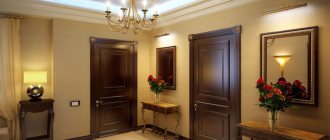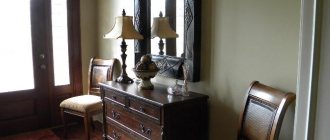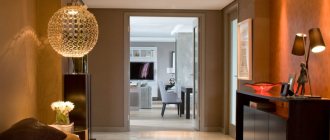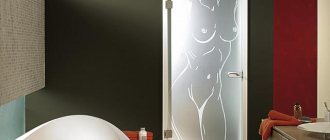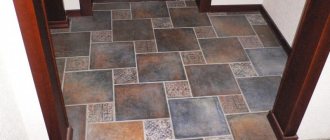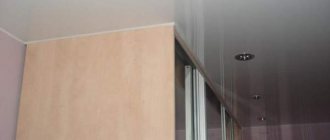The hallway and corridor are the most accessible rooms in a home, so the floors in them are constantly under increased load. It is in the hallway that sand and dirt from shoes get into, which are abrasives with all the ensuing consequences. What should the floor be made of in the hallway and corridor so that it does not lose its appearance? It should be understood that everything depends on specific cases. If one person lives in an apartment, then you can cover the floor with anything. If there are several adults, children and pets living in the house, then you need to choose something stronger. Let's look at several flooring options and list the pros and cons of each.
PRIMARY REQUIREMENTS
The floor in the corridor and hallway should be:
- wear-resistant;
- moisture resistant;
- easy to clean and wash;
- withstands high pressure and shock.
The floor in the hallway should be wear-resistant and easy to clean
You will wash the floors in these rooms most often, so we recommend that you choose flooring with the smoothest surface possible so that dirt does not get stuck in all the cracks and relief.
Requirements for covering in the corridor
The area near the front door receives massive impact from thin stiletto heels and shoes with hard and dirty soles. Often snow, salt and chemicals are brought here from the street. All this leaves its mark on the requirements that apply to the coverage in this part of the apartment.
Combined with the need to create a pleasant first impression upon entering the home, the floor covering in the hallway must meet the following parameters:
- be wear-resistant;
- do not interact with chemicals;
- be easy to care for;
- have an attractive appearance.
Today, choosing flooring has become much easier: the market offers many options and types of materials. It is easier to make the right choice after familiarizing yourself with their characteristics and possibilities of use.
PORCELAIN TILES AND CERAMIC TILES
This is one of the best options for walk-through rooms. Ceramics are made from clay fired at high temperatures. Due to baking, it becomes very dense and durable, easily withstanding heavy loads. Tiles and porcelain tiles can be of completely different shapes, sizes and colors - you can always choose the right option. It also comes in glossy and matte, glazed and unglazed, enameled, etc.
The tiles on the floor in the hallway can even be laid with a “warm floor” system. The main advantages of this material:
- Affordable price.
- Easy to install.
- Excellent durability.
- Easy to clean.
- Wear resistance.
- Ecological cleanliness.
- Huge range of colors and shapes.
The tiles do not allow moisture to pass through, are practically scratch-resistant, and can be used in any premises with high loads. It is great for the corridor and hallway. You can purchase tiles from both Russian and foreign production. The downside is fragility. If you drop a hammer on a tile, you will probably have to replace it. Also, certain disadvantages include the “wet” installation process, although it can be installed in one day and the second day you can safely walk on the frozen floor.
Repair progress
The absolute assistant in repairs is Google. He doesn't hide anything if you question him thoroughly. I found a lot of videos that clearly show the entire process of laying tiles.
I didn't find anything wrong. I walked over the surface of the floor with a broom and removed the dust (it had not yet had time to settle after the disappearance of my husband, but the instructions are instructions).
I diluted the adhesive mixture in a plastic bucket according to the proportions written on the package. For better adhesion, I wet the inside of the tile with water.
For this purpose I used a whitewash brush.
She laid out the tiles, starting from a row of two tile strips that had already dried to the floor.
Gradually, as the covered area increased, I spread the mixture onto the floor in a 5 mm layer. The rough side of the tile was also coated with a notched trowel with a layer of approximately 3-4 mm.
The rough side of the tile looks like this. I appreciated the notched trowel, which helped to firmly compact the glue into the tractor strips
I inserted crosses between the tiles in order to maintain intervals, two crosses on each face, everything as it should be. She knocked on top with her fist and leveled it in height.
Using a ruler, I aligned it along the length. After drying, I pulled out the crosses and washed them. What if I get fired from my job, I’ll work part-time doing repairs, and I’ll need them?
The ambush happened with the grout. For some inexplicable reason, it took me more than I should have. And I didn’t take into account that the tile would have to be trimmed, and its small elements could be useful.
Initially, I didn't have much luck with pruning. I prayed before picking up the jigsaw, but it didn't help much. I ruined five tiles.
Also, I still don’t know what a level is and how it can help when the tiles are already “sitting on the floor.”
LAMINATE
Laminate flooring in the hallway is a fairly practical and profitable solution. Laminate is a modern material consisting of several layers glued together under high pressure. Class 32 laminate is suitable for the hallway, although if you have large dogs, you can also use class 33. The average service life is about 10 years (for commercial laminate it can be up to 15).
The main advantages of laminate:
- Affordable price.
- Good density, resistance to loads and impacts.
- Great looks.
- Good thermal insulation.
- Wear resistance.
- Easy to install.
Laminate flooring is perfect for hallways and hallways
Laminate is available in the form of lamellas. It is usually made to look like wood, but the market offers options for tiles, natural stone, parquet, etc. The disadvantages of laminate include its fear of moisture (although you can always buy a moisture-resistant one), as well as quite complex repairs in case of damage. It is very easy to install - even a novice home craftsman can handle it.
Note:
Under the laminate it is mandatory to lay a substrate. It gives the coating heat and sound insulating properties, and also protects it from subsidence.
How to design a corridor?
When starting to renovate a hallway, evaluate the size of the space and consider whether there is enough light entering the room. Modern technologies offer many different options for corridor lighting - these can be either traditional ceiling lamps and sconces, or built-in light sources. An excellent solution for a narrow corridor is track lamps: they can be stretched over the entire length of the room and achieve uniform illumination. Do not overload the space with decor; it is better to focus on the design of the walls - for example, through original wallpaper for the corridor. And don’t forget to use photos of finished projects with the best solutions from professional designers for inspiration when thinking through the design of a corridor. If you are just looking for ideas for renovation and arrangement or already know for sure that a corridor is your option, we have collected for you 237,907 photos from real projects of interior designers, decorators and architects from Russia and around the world, including such proven professionals as Grigory Sokolinsky and Ekaterina Fedorova. The beautiful corridors in our photographs are the best examples of competent design and layout in different styles and colors. If you like any design option, for example the corridor from the second photo, you can contact the author and order the ideal design project for yourself. See our photo gallery, look for inspiration and professionals, and you will see why Houzz is the best resource for apartment and home interior design, renovation, home construction, architecture and landscape design.
PARQUET AND PARQUET BOARDS
Parquet consists of small lamellas that are laid with glue. They are covered with several layers of varnish on top, protecting the material from moisture and abrasion. Parquet board is similar to laminate. It also consists of several layers, has locks and spikes, is quickly assembled and serves well. But for a hallway this is not the best choice. Firstly, the varnish will be quickly wiped off with abrasives. Secondly, it may turn yellow from detergents. Thirdly, parquet boards are very scratched and are afraid of moisture. This type of covering is best suited for a living room, bedroom, or office. But if you want a wooden floor, then nothing prevents you from laying parquet. Just take proper care of it and treat it with special impregnations on time.
The main advantages of parquet and parquet boards:
- Beautiful appearance.
- Good strength.
- Durability.
The main disadvantages are the high price, the need for constant maintenance, fear of moisture and scratches. For parquet, you will have to perfectly level the floor and then cover it with moisture-resistant plywood, which means additional costs. The board under the parquet also requires a flat base, but it is easier to lay it.
Note:
Many traders add its environmental friendliness to the advantages of parquet. In fact, it is leveled out by a large number of impregnations and varnishes applied to it. Choosing parquet just because it is environmentally friendly is fundamentally wrong.
Natural materials
For those who are particularly concerned about the eco-friendliness of their kitchen or hallway floors, natural materials such as wood, cork or bamboo are the best options. Of course, they are in a much higher price category than the previous options, but the costs are more than offset by the first-class appearance, durability of the material and improvement of the microclimate of the home.
Parquet made from natural deciduous wood is highly durable, but it needs to be looked after very carefully and handled with particular care, since wood is very easily saturated with moisture, is susceptible to stubborn stains, and expands and shrinks when exposed to temperature. In addition, without proper treatment, the wood can simply rot.
Cork is an interesting option, although it has not found much popularity. Cork flooring has significant advantages: it combines the softness and warmth of linoleum, the environmental friendliness of wood and the durability of ceramics. In addition, walking in traffic has a beneficial effect on human health.
It is worth carefully choosing balsa wood, since in terms of water resistance it can be both susceptible and good at repelling moisture. The disadvantages of cork include its high price, complex installation technology, which almost certainly requires the involvement of specialists, and difficulty in maintaining due to its rough texture.
Bamboo is a rather exotic material for flooring. It is supplied both in the form of boards and in rolls, glued to a paper backing. A wide range of colors and textures allows bamboo parquet to seamlessly fit into any interior design. This material has decent strength and lasts a long time even in frequently visited areas.
Related article: What is the best glue to use for wallpaper: expert opinion
Environmental friendliness and hypoallergenicity will serve the health of residents well. Easy to clean as it is antistatic and more resistant to dust and dirt than other materials. However, bamboo is susceptible to physical damage, such as damage from sharp objects, and also deteriorates in sunlight.
Thus, the choice of materials on the market is quite extensive. The choice of suitable flooring for your kitchen or hallway is up to you - whether you are traditional or want something exotic. And the described pros and cons will help you make the right choice.
CARPET
Carpet is an analogue of carpet. It can be artificial (synthetic) or natural (jute). The average service life of carpet is about 10-15 years with proper care.
It is advisable to use carpet only in apartments
Should I lay carpet in the hallway or hallway? This is not the best option. In fact, you can lay it, you can even combine it with a warm floor system. You will have a warm, soft, and comfortable surface to walk on. But this option is only suitable for an apartment inhabited by 1-2 people without children. Carpet absorbs moisture quite well, but it is difficult to clean. For a home, this is not the best solution, because from the street you immediately get into the hallway and bring a lot of sand and dirt into it. Nylon carpet is best suited for laying in the corridor. Choose a material with maximum density (about 2000 g/m2) and minimum pile length.
Main advantages:
- Soft, pleasant to the touch surface.
- Low thermal conductivity.
- Good service life.
- Beautiful appearance.
- Nice price
The disadvantages of carpeting include the difficulty of caring for it and the fear of moisture.
Floor tiles in the hallway
In the hallway, the floor is regularly subjected to frequent washing, the action of reagents carried on shoes, and some shoe models can cause damage to the soft surface. Therefore, floor tiles in the hallway are the most practical and at the same time aesthetic covering option.
Note! Our partners, Stroytekhmontazh LLC, always have laminated plywood in Moscow - the lowest prices and the highest quality!
Many people think about flooring in the hallway, and if linoleum is increasingly less of a choice, then laminate competes with tiles. From a practical point of view, no laminate can compare in terms of stability with ceramic tiles.
LINOLEUM
A classic floor covering that enjoys well-deserved popularity all over the world. Linoleum is great for hallways and corridors. It lasts 7-10 years, is not afraid of moisture, and is easy to clean. Its advantages:
- Good wear resistance.
- Affordable price.
- Easy to install.
- Wide range of colors.
- Easy to care for.
But still, linoleum also has certain disadvantages. He doesn't like pressure very much and squats under furniture. In principle, it’s okay if you don’t plan to move the cabinet from place to place. But if you decide to move it or the bedside table to the opposite wall, dents will probably remain on it.
Also, linoleum needs a flat, prepared base, so you may need to fill the screed or lay fiberboard sheets.
Linoleum is perfect for hallways and corridors
We reviewed almost all available materials for flooring in the hallway. The most practical are tiles, linoleum and laminate in the hallway. You can lay parquet or carpet, but you will have to take more careful care of these materials.
↑ Tricky tricks of designers
It's no secret that different colors and textures can visually change a space. Thus, a transverse or diagonal pattern of the flooring will expand a narrow, elongated corridor, while dark shades will help, on the contrary, to visually reduce a large, spacious room.
Small hallway? No problem! Use cool shades of gray, blue, brown and your “reception” will look as if there are not 3 squares, but all 5. In addition, you can expand the narrow corridor using this technique: in the places where the corridor connects with other rooms, you should lay the same material . For example, if the floor in the hallway is tiled, then there should also be tiles on the threshold of the kitchen, bathroom, living room or bedroom. Such a transition will provide the effect that is necessary in this case.
Some go even further and increase the space of a narrow corridor by combining different materials. Ceramic tiles go well with laminate, and linoleum with parquet. In addition, this technique allows you to divide the room into several functional zones: a work area for shoes and hangers with clothes, and a front area for receiving guests.
Combining materials is a great way to divide the space of the corridor and...
... visually enlarge it
If you decide to use the combination technique, remember: in the work area you need to use the most durable coating, such as ceramic tiles or porcelain stoneware, and in the reception area, place greater emphasis on aesthetics.
